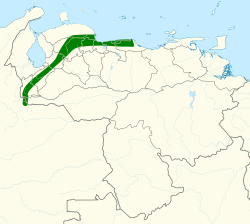Behavior
Movement
The violet-chested hummingbird is sedentary. [8]
Feeding
The violet-chested hummingbird usually forages for nectar deep in the forest, typically in dense understory and often in damp ravines and Heliconia thickets. It defends flower patches and never gathers with other hummingbirds at large flowering events. [8]
Breeding
The violet-chested hummingbird's breeding season spans from March to July in Lara state and also in November and December in other parts of its range. It builds a cup nest, usually in a branch fork but sometimes on a vine or fern, and typically about 2 m (7 ft) above the ground. The nest is made of soft plant fibers with an outer layer of moss, tree fern scales, and lichen. The female incubates the clutch of two eggs for an average of about 20 days and fledging occurs about 26 days after hatch. [9] [8]
 | Songs and calls
|
Vocalization
The violet-chested hummingbird's primary song is a "series of sharp 'chit! ... chit! ... chit!...' notes". Another song is "'chip' and 'weet' notes together with short, squeaky trills". While foraging it makes "loud, staccato chipping notes". [8]
This page is based on this
Wikipedia article Text is available under the
CC BY-SA 4.0 license; additional terms may apply.
Images, videos and audio are available under their respective licenses.










